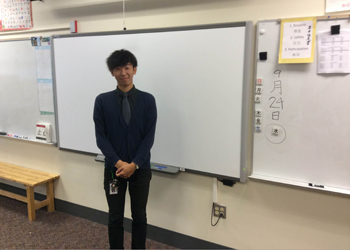

 2014 J-LEAP Report
2014 J-LEAP Report
Chief Sealth International High School
Seattle, WA
Hello. My name is Tomoki Nodo and I am currently working as an assistant teacher at Chief Sealth International High School in Seattle, Washington. Almost two months has passed since I arrived here in Seattle.
Before I came here, I had never worked professionally as a teacher. In fact I had never worked as an adult member of society. Last March, I graduated from a University in Osaka so this is the first challenge for me as an adult, living and working at a high school in the U.S. In addition, I had never been to the U.S., so everything I see, everywhere I go and everything I have experienced in this country is really brand new and deeply fascinating for me. When I was a university student, I studied a little about the culture and education system here so I did not expect I would be as surprised as I am now. After I arrived at this new place, a lot of people (some of them are teachers and others are not related to education) taught me numerous things. However, since it has only been about a month since high school started, I would like to introduce my first and biggest challenge so far at this school.
I would like to introduce the city where I am staying before talking about my life at the high school. Washington is located in northwestern part of the country and is known as the Evergreen State with its wonderful nature and its never-ending color of green. Although the climate is really comfortable in summer, most days in other seasons are rainy. During rainy season, some people in Washington get SAD, Seasonal Affective Disorder, because of short daylight hours. Though I knew it before I came, most people I met told me “Even in rainy season, we can also enjoy that atmosphere.” Although I do not know whether the rainy season is good or not for people, it is good for growing plants in this evergreen state. Because the rainy season has not come yet, I really like Seattle so far.
Next, I would like to introduce Chief Sealth International High School where I work at. This school opened in 1957 in the southwestern part of Seattle and it is a comprehensive high school that offers a wide array of opportunities for students to learn in a multi-cultural environment. Students can experience various cultures from other countries in an environment that is ideal for international education. In world language classes, there are four languages that students can choose from including Arabic, Chinese, Spanish and Japanese. In addition to this, there are also Spanish immersion classes. This school doesn’t just focus on students but also staff members who are part of the team. Teachers have opportunities to take lectures and participate in training programs for International education. Through these programs, teachers can brush up on their teaching skills. One training program that I took part in was about assessment in International Education during the 21st century presented by Asia society. For world language teachers, every class is related to International Education, but this training opportunity included many teachers from other subjects and we discussed about how we raise our students to the level of world citizens. We exchanged various ideas from different positions so we can share the same image for each class as a member of one team. These are the main things I have learned in one month. I think there might be more characteristics to an International high school, but I have not yet experienced enough to objectively explain this innovative approach to teaching.
Next, I would like to introduce Japanese classes at my school. There are four levels of Japanese including 1, 2, 3 and 4. Some years, level 5 is also offered. We offer an IB (International Baccalaureate) program, with Japanese 3 and 4 being part of this. Japanese 1 and 2 are divided into two classes and Japanese 3 and 4 are held during the same period. We currently have a total of 120 students taking Japanese. Some of them have connections with Japan in various capacities. For instance, some of them have Japanese family members and others have been to or stayed in Japan. For these students, Japanese is not an unfamiliar language. Of course, more than half of students who take Japanese class have never learned Japanese. In order to let all students learn while having fun, Joshua Sensei, who is my lead teacher, and I make plans and cooperate in class. However, since only three weeks have passed since class started, there have been many difficulties for me. The biggest is instruction for students. Instructions must be short, clear and easy to understand. If one of those things is lacking, student will get confused. Even instruction for Japanese students in Japan was not easy for me so, for now, it is much more difficult. Every day, every class, new difficulties come up and it can get me a little depressed, but I wanted to be a Japanese language teacher, so I am happy to face to these challenges.
In September 2013, just a year ago, I decided to apply for this program. The first thing I did was read reports like this by former J-LEAP participants. At that time, I could not imagine that I would be here, but I am here now because of the support I received from everyone around me. I really appreciate them all.
Thank you very much for reading this article.